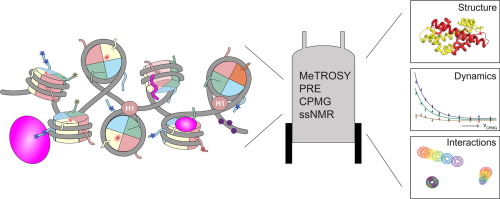当前位置:
X-MOL 学术
›
Prog. Nucl. Magn. Reson. Spectrosc.
›
论文详情
Our official English website, www.x-mol.net, welcomes your
feedback! (Note: you will need to create a separate account there.)
Unspinning chromatin: Revealing the dynamic nucleosome landscape by NMR
Progress in Nuclear Magnetic Resonance Spectroscopy ( IF 7.3 ) Pub Date : 2019-02-01 , DOI: 10.1016/j.pnmrs.2019.01.002 Clara L. van Emmerik , Hugo van Ingen
Progress in Nuclear Magnetic Resonance Spectroscopy ( IF 7.3 ) Pub Date : 2019-02-01 , DOI: 10.1016/j.pnmrs.2019.01.002 Clara L. van Emmerik , Hugo van Ingen

|
NMR is an essential technique for obtaining information at atomic resolution on the structure, motions and interactions of biomolecules. Here, we review the contribution of NMR to our understanding of the fundamental unit of chromatin: the nucleosome. Nucleosomes compact the genome by wrapping the DNA around a protein core, the histone octamer, thereby protecting genomic integrity. Crucially, the imposed barrier also allows strict regulation of gene expression, DNA replication and DNA repair processes through an intricate system of histone and DNA modifications and a wide range of interactions between nucleosomes and chromatin factors. In this review, we describe how NMR has contributed to deciphering the molecular basis of nucleosome function. Starting from pioneering studies in the 1960s using natural abundance NMR studies, we focus on the progress in sample preparation and NMR methodology that has allowed high-resolution studies on the nucleosome and its subunits. We summarize the results and approaches of state-of-the-art NMR studies on nucleosomal DNA, histone complexes, nucleosomes and nucleosomal arrays. These studies highlight the particular strength of NMR in studying nucleosome dynamics and nucleosome-protein interactions. Finally, we look ahead to exciting new possibilities that will be afforded by on-going developments in solution and solid-state NMR. By increasing both the depth and breadth of nucleosome NMR studies, it will be possible to offer a unique perspective on the dynamic landscape of nucleosomes and its interacting proteins.
中文翻译:

解旋染色质:通过核磁共振揭示动态核小体景观
核磁共振是获取有关生物分子结构、运动和相互作用的原子分辨率信息的基本技术。在这里,我们回顾了 NMR 对我们理解染色质的基本单位:核小体的贡献。核小体通过将 DNA 包裹在蛋白质核心(组蛋白八聚体)周围来压缩基因组,从而保护基因组完整性。至关重要的是,施加的屏障还允许通过复杂的组蛋白和 DNA 修饰系统以及核小体和染色质因子之间的广泛相互作用来严格调控基因表达、DNA 复制和 DNA 修复过程。在这篇综述中,我们描述了 NMR 如何有助于破译核小体功能的分子基础。从 1960 年代使用自然丰度 NMR 研究的开创性研究开始,我们专注于样品制备和 NMR 方法方面的进展,这使得对核小体及其亚基进行高分辨率研究成为可能。我们总结了对核小体 DNA、组蛋白复合物、核小体和核小体阵列的最先进 NMR 研究的结果和方法。这些研究突出了 NMR 在研究核小体动力学和核小体-蛋白质相互作用方面的特殊优势。最后,我们期待着溶液和固态 NMR 的持续发展将带来令人兴奋的新可能性。通过增加核小体核磁共振研究的深度和广度,将有可能为核小体及其相互作用蛋白质的动态景观提供独特的视角。我们总结了对核小体 DNA、组蛋白复合物、核小体和核小体阵列的最先进 NMR 研究的结果和方法。这些研究突出了 NMR 在研究核小体动力学和核小体-蛋白质相互作用方面的特殊优势。最后,我们期待着溶液和固态 NMR 的持续发展将带来令人兴奋的新可能性。通过增加核小体核磁共振研究的深度和广度,将有可能为核小体及其相互作用蛋白质的动态景观提供独特的视角。我们总结了对核小体 DNA、组蛋白复合物、核小体和核小体阵列的最先进 NMR 研究的结果和方法。这些研究突出了 NMR 在研究核小体动力学和核小体-蛋白质相互作用方面的特殊优势。最后,我们期待着溶液和固态 NMR 的持续发展将带来令人兴奋的新可能性。通过增加核小体核磁共振研究的深度和广度,将有可能为核小体及其相互作用蛋白质的动态景观提供独特的视角。最后,我们期待着溶液和固态 NMR 的持续发展将带来令人兴奋的新可能性。通过增加核小体核磁共振研究的深度和广度,将有可能为核小体及其相互作用蛋白质的动态景观提供独特的视角。最后,我们期待着溶液和固态 NMR 的持续发展将带来令人兴奋的新可能性。通过增加核小体核磁共振研究的深度和广度,将有可能为核小体及其相互作用蛋白质的动态景观提供独特的视角。
更新日期:2019-02-01
中文翻译:

解旋染色质:通过核磁共振揭示动态核小体景观
核磁共振是获取有关生物分子结构、运动和相互作用的原子分辨率信息的基本技术。在这里,我们回顾了 NMR 对我们理解染色质的基本单位:核小体的贡献。核小体通过将 DNA 包裹在蛋白质核心(组蛋白八聚体)周围来压缩基因组,从而保护基因组完整性。至关重要的是,施加的屏障还允许通过复杂的组蛋白和 DNA 修饰系统以及核小体和染色质因子之间的广泛相互作用来严格调控基因表达、DNA 复制和 DNA 修复过程。在这篇综述中,我们描述了 NMR 如何有助于破译核小体功能的分子基础。从 1960 年代使用自然丰度 NMR 研究的开创性研究开始,我们专注于样品制备和 NMR 方法方面的进展,这使得对核小体及其亚基进行高分辨率研究成为可能。我们总结了对核小体 DNA、组蛋白复合物、核小体和核小体阵列的最先进 NMR 研究的结果和方法。这些研究突出了 NMR 在研究核小体动力学和核小体-蛋白质相互作用方面的特殊优势。最后,我们期待着溶液和固态 NMR 的持续发展将带来令人兴奋的新可能性。通过增加核小体核磁共振研究的深度和广度,将有可能为核小体及其相互作用蛋白质的动态景观提供独特的视角。我们总结了对核小体 DNA、组蛋白复合物、核小体和核小体阵列的最先进 NMR 研究的结果和方法。这些研究突出了 NMR 在研究核小体动力学和核小体-蛋白质相互作用方面的特殊优势。最后,我们期待着溶液和固态 NMR 的持续发展将带来令人兴奋的新可能性。通过增加核小体核磁共振研究的深度和广度,将有可能为核小体及其相互作用蛋白质的动态景观提供独特的视角。我们总结了对核小体 DNA、组蛋白复合物、核小体和核小体阵列的最先进 NMR 研究的结果和方法。这些研究突出了 NMR 在研究核小体动力学和核小体-蛋白质相互作用方面的特殊优势。最后,我们期待着溶液和固态 NMR 的持续发展将带来令人兴奋的新可能性。通过增加核小体核磁共振研究的深度和广度,将有可能为核小体及其相互作用蛋白质的动态景观提供独特的视角。最后,我们期待着溶液和固态 NMR 的持续发展将带来令人兴奋的新可能性。通过增加核小体核磁共振研究的深度和广度,将有可能为核小体及其相互作用蛋白质的动态景观提供独特的视角。最后,我们期待着溶液和固态 NMR 的持续发展将带来令人兴奋的新可能性。通过增加核小体核磁共振研究的深度和广度,将有可能为核小体及其相互作用蛋白质的动态景观提供独特的视角。











































 京公网安备 11010802027423号
京公网安备 11010802027423号